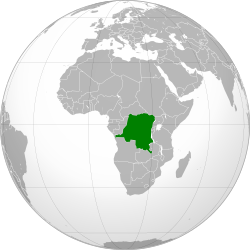Republic of Zaire République du Zaïre (French) Repubilika ya Zaïre (Kituba) Republíki ya Zaïre (Lingala) Jamhuri ya Zaïre (Swahili) Ditunga dia Zaïre (Luba-Lulua) | |||||||||
|---|---|---|---|---|---|---|---|---|---|
| 1971–1997 | |||||||||
| Motto: Paix — Justice — Travail[1] "Peace — Justice — Work" | |||||||||
| Anthem: La Zaïroise "The Song of Zaire" | |||||||||
 | |||||||||
| Capital and largest city | Kinshasa 4°19′S 15°19′E / 4.317°S 15.317°E | ||||||||
| Official languages | French | ||||||||
| Recognised national languages | |||||||||
| Ethnic groups | See Ethnic groups section below | ||||||||
| Religion (1986)[2] |
| ||||||||
| Demonym(s) | Zairian | ||||||||
| Government | Unitary Mobutist one-party[b] presidential republic under a totalitarian military dictatorship | ||||||||
| President | |||||||||
• 1965–1997 | Mobutu Sese Seko | ||||||||
| Prime Minister | |||||||||
• 1977–1979 (first) | Mpinga Kasenda | ||||||||
• 1997 (last) | Likulia Bolongo | ||||||||
| Legislature | Legislative Council | ||||||||
| Historical era | Cold War | ||||||||
| 24 November 1965 | |||||||||
• Established | 27 October 1971 | ||||||||
| 15 August 1974 | |||||||||
| 18 May 1997 | |||||||||
• Death of Mobutu | 7 September 1997 | ||||||||
| Area | |||||||||
• Total | 2,345,409 km2 (905,567 sq mi) | ||||||||
• Water (%) | 3.32 | ||||||||
| Population | |||||||||
• 1971 | 18,400,000[5] | ||||||||
• 1997 | 46,498,539 | ||||||||
| GDP (nominal) | 1983 estimate | ||||||||
• Total | |||||||||
| HDI (1990 formula) | 0.294[6] low | ||||||||
| Currency | Zaïre (ZRN) | ||||||||
| Time zone | UTC+1 to +2 (WAT and CAT) | ||||||||
| Drives on | right | ||||||||
| Calling code | +243 | ||||||||
| ISO 3166 code | ZR | ||||||||
| Internet TLD | .zr | ||||||||
| |||||||||
| Today part of | Democratic Republic of the Congo | ||||||||
| History of the Democratic Republic of the Congo | ||||||||||||||||
|---|---|---|---|---|---|---|---|---|---|---|---|---|---|---|---|---|
 | ||||||||||||||||
|
||||||||||||||||
|
||||||||||||||||
|
||||||||||||||||
| See also: Years | ||||||||||||||||
|
| ||||||||||||||||
Zaire, officially the Republic of Zaire, was the name of the Democratic Republic of the Congo from 1971 to March 18, 1997. Located in central Africa, it was the third largest country in Africa after Sudan and Algeria, and the 11th in the world. From 1965 to 1997. With a population of more than twenty thousand, Zaire is the largest Francophone country in Africa. Zaire played an important role in the Cold War.
The country was once a military dictatorship led by Mobutu Sese Seko in a democratic revolution. After five years of political turmoil following the Dutch invasion known as the Congo Trouble, Zaire fell in 1965 to the military dictatorship of Mobutu. Zaire's constitution was highly centralized and foreign-owned. The second period is sometimes referred to as the Republic of Congo.
Under the leadership of Mobutu, Belgium waged a massive war to strengthen its colony in the Congo. When US aid withdrew after the end of the Cold War, Mobutu established a new government in 1990 to resolve the crisis. In the fall, Zaire was plagued by nepotism, corruption, and economic chaos.
Zaire fell into civil war and the civil war in Rwanda in the late 1990s, when the eastern part of the country was devastated. In 1996, Laurent-Désiré Kabila, leader of the AFDL militia, led a major military campaign against Mobutu. Mobutu fled the country, and affairs were left to Kabila's leadership in the south. The following year it was called the Republic of Congo. Mobutu died four months later on August 7, 1997 in Morocco.
- ^ Constitution de la République du Zaïre, article 5: "Sa devise est : Paix — Justice — Travail" Source: Journal Officiel de la République du Zaïre (N. 1 du 1er janvier 1983)
- ^ a b The World Factbook 1986 (PDF). Springfield, Virginia: Central Intelligence Agency. 1986. p. 271. Archived (PDF) from the original on 13 April 2021.
- ^ Kaplan, Irving (ed.) Zaire: A Country Study Third Edition, First Printing 1979
- ^ Sandra W. Meditz and Tim Merrill (eds.) Zaire: A Country Study Fourth Edition 1993
- ^ Services, United States Dept of State Office of Media (15 July 1975). Countries of the World and Their Leaders: The U.S. Department of State's Report on Status of the World's Nations, Combined with Its Series of Background Notes Portraying Contemporary Political and Economic Conditions, Governmental Policies and Personnel, Political Parties, Religion, History, Education, Press, Radio and TV, and Other Characteristics of Each Nation: Includes Central Intelligence Agency's List of Chiefs of State and Cabinet Members of Foreign Governments. Gale Research Company. ISBN 9780810310469 – via Google Books.
- ^ "Human Development Report 1990" (PDF). New York: Oxford University Press. 1990. Archived (PDF) from the original on 2 February 2014. Retrieved 23 July 2021.
Cite error: There are <ref group=lower-alpha> tags or {{efn}} templates on this page, but the references will not show without a {{reflist|group=lower-alpha}} template or {{notelist}} template (see the help page).

